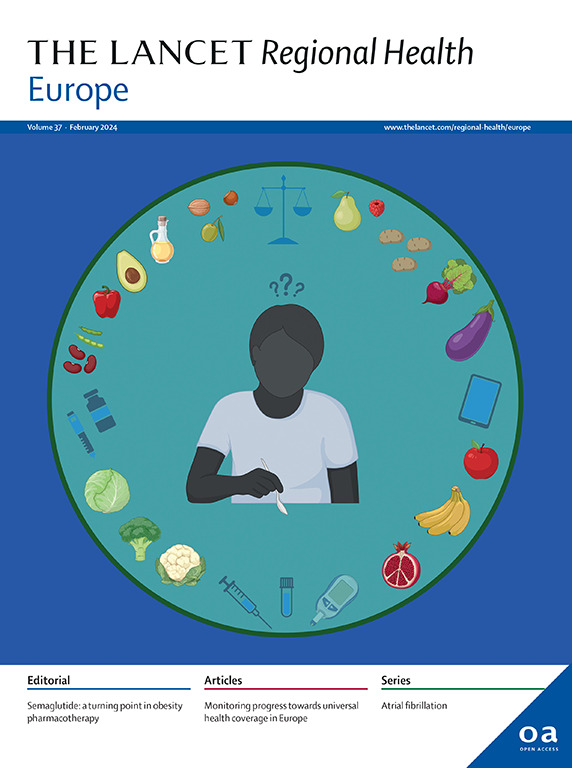Fertility, time to pregnancy, and pregnancy outcomes among women with recurrent miscarriages in the UK: a prospective observational longitudinal study
IF 13
Q1 HEALTH CARE SCIENCES & SERVICES
引用次数: 0
Abstract
Background
Recurrent miscarriage is a debilitating disorder associated with considerable physical and psychological morbidity. An estimated 50% of first trimester miscarriages remain unexplained. The aim of this study was to provide a personalised framework to guide the expectations of women experiencing recurrent miscarriage, with the ultimate goal of transforming clinical practice.
Methods
We used real-world data from a UK longitudinal study of 1201 couples attending National Health Service (NHS) miscarriage clinics, with a history of previous miscarriages, comprising medical and obstetric history, results of investigations and pregnancy and neonatal outcome. We developed, parametrised, and validated predictive models for the probability that the next pregnancy is viable and for the time to next pregnancy. Time to next pregnancy separates couples into two groups, a group with subfertility, i.e., delay in conception, and a group with no significant delay in conception. We used Bayesian inference for the latter model.
Trial registration number: The prospective data collections were pre-registered ISRCTN17732518; https://doi.org/10.1186/ISRCTN17732518.
Findings
Predictive models of the time to pregnancy, the probability of the couple being subfertility and the probability of having a viable pregnancy can be parametrised from longitudinal study data. We identified several predictors for such models. In the viable pregnancy model, increased maternal age, higher Body Mass Index (BMI), having Polycystic Ovaries Syndrome (PCOS) and the number of previous miscarriages were associated with reduced odds of viable pregnancy. In contrast, having had previous live births increased the odds of a viable pregnancy. Model validation against a second external dataset gave an Area Under Curve (AUC) of 0.65 (95% Confidence Interval (CI): 0.55, 0.76). Of the 942 women referred to our recurrent miscarriage clinics and followed up over a period of 3 years, 10.7% (101) did not conceive during this time, indicating a potential subfertility problem. In the time to pregnancy model, increased maternal age, higher BMI, and smoking were associated with reduced likelihood of conception. Conversely, taking folic acid supplements and having a history of previous conceptions were associated with increased fertility. In our cohort, 53.4% (577 out of 1080 women) reported a pregnancy within 12 months. Additionally, 22.8% (277 out of 996 women who were followed up over a 2-year period) experienced a first pregnancy event in the second year. The area under the curve (AUC) for predicting pregnancy within 12 months was 0.60 (95% CI: 0.50–0.70) in an external validation using a second dataset.
Interpretation
The pregnancy journey can be predicted on a personalised basis by integrating the validated models. We provide a framework for evidence-based management of women with miscarriage, comprising informed decision-making, including optimal referral to fertility services, and a tailored insight into fertility outcomes, thereby guiding expectations and providing psychological support.
Funding
Tommy's National Centre for Miscarriage Research.
英国反复流产妇女的生育能力、妊娠时间和妊娠结局:一项前瞻性观察性纵向研究
背景:复发性流产是一种使人衰弱的疾病,与相当多的生理和心理疾病相关。据估计,50%的妊娠早期流产原因不明。本研究的目的是提供一个个性化的框架来指导反复流产妇女的期望,最终目标是改变临床实践。方法:我们使用了来自英国的一项纵向研究的真实数据,研究对象为1201对在国家卫生服务(NHS)流产诊所就诊的夫妇,他们有过流产史,包括医疗和产科史、调查结果以及妊娠和新生儿结局。我们开发、参数化并验证了下一次妊娠存活概率和下一次妊娠时间的预测模型。下次怀孕的时间将夫妇分为两组,一组生育能力低下,即受孕延迟,另一组没有明显的受孕延迟。对于后一个模型,我们使用贝叶斯推理。试验注册号:预期数据收集为预注册ISRCTN17732518;https://doi.org/10.1186/ISRCTN17732518.FindingsPredictive怀孕时间的模型,夫妇生育能力低下的概率和怀孕成功的概率可以从纵向研究数据中参数化。我们确定了这种模型的几个预测因子。在可存活妊娠模型中,母亲年龄增加、身体质量指数(BMI)升高、患有多囊卵巢综合征(PCOS)和既往流产次数与可存活妊娠几率降低相关。相比之下,有过活产经历的女性成功怀孕的几率更高。针对第二个外部数据集的模型验证给出了0.65的曲线下面积(AUC)(95%置信区间(CI): 0.55, 0.76)。在我们的复发性流产诊所就诊的942名妇女中,有10.7%(101名)在这段时间内没有怀孕,这表明存在潜在的生育能力低下问题。在妊娠期模型中,母亲年龄增加、体重指数升高和吸烟与受孕可能性降低有关。相反,服用叶酸补充剂和有怀孕史与生育能力增加有关。在我们的队列中,53.4%(1080名妇女中的577名)报告在12个月内怀孕。此外,22.8%(996名妇女中有277名在2年期间随访)在第二年经历了第一次怀孕事件。在使用第二个数据集的外部验证中,预测12个月内怀孕的曲线下面积(AUC)为0.60 (95% CI: 0.50-0.70)。通过整合经过验证的模型,可以在个性化的基础上预测怀孕过程。我们为流产妇女的循证管理提供了一个框架,包括知情决策,包括最佳的生育服务转诊,以及对生育结果的量身定制的洞察,从而指导预期并提供心理支持。资助汤米国家流产研究中心。
本文章由计算机程序翻译,如有差异,请以英文原文为准。
求助全文
约1分钟内获得全文
求助全文
来源期刊

Lancet Regional Health-Europe
Multiple-
CiteScore
19.90
自引率
1.40%
发文量
260
审稿时长
9 weeks
期刊介绍:
The Lancet Regional Health – Europe, a gold open access journal, is part of The Lancet's global effort to promote healthcare quality and accessibility worldwide. It focuses on advancing clinical practice and health policy in the European region to enhance health outcomes. The journal publishes high-quality original research advocating changes in clinical practice and health policy. It also includes reviews, commentaries, and opinion pieces on regional health topics, such as infection and disease prevention, healthy aging, and reducing health disparities.
 求助内容:
求助内容: 应助结果提醒方式:
应助结果提醒方式:


